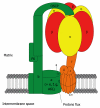Ecto-F₁-ATPase: a moonlighting protein complex and an unexpected apoA-I receptor
- PMID: 21157968
- PMCID: PMC3007107
- DOI: 10.3748/wjg.v16.i47.5925
Ecto-F₁-ATPase: a moonlighting protein complex and an unexpected apoA-I receptor
Abstract
Mitochondrial ATP synthase has been recently detected at the surface of different cell types, where it is a high affinity receptor for apoA-I, the major protein component in high density lipoproteins (HDL). Cell surface ATP synthase (namely ecto-F₁-ATPase) expression is related to different biological effects, such as regulation of HDL uptake by hepatocytes, endothelial cell proliferation or antitumor activity of Vγ9/Vδ2 T lymphocytes. This paper reviews the recently discovered functions and regulations of ecto-F₁-ATPase. Particularly, the role of the F₁-ATPase pathway(s) in HDL-cholesterol uptake and apoA-I-mediated endothelial protection suggests its potential importance in reverse cholesterol transport and its regulation might represent a potential therapeutic target for HDL-related therapy for cardiovascular diseases. Therefore, it is timely for us to better understand how this ecto-enzyme and downstream pathways are regulated and to develop pharmacologic interventions.
Figures


References
-
- Lewalter K, Müller V. Bioenergetics of archaea: ancient energy conserving mechanisms developed in the early history of life. Biochim Biophys Acta. 2006;1757:437–445. - PubMed
-
- Ko YH, Delannoy M, Hullihen J, Chiu W, Pedersen PL. Mitochondrial ATP synthasome. Cristae-enriched membranes and a multiwell detergent screening assay yield dispersed single complexes containing the ATP synthase and carriers for Pi and ADP/ATP. J Biol Chem. 2003;278:12305–12309. - PubMed
-
- Wittig I, Schägger H. Advantages and limitations of clear-native PAGE. Proteomics. 2005;5:4338–4346. - PubMed
Publication types
MeSH terms
Substances
LinkOut - more resources
Full Text Sources

